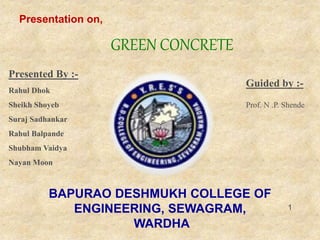
Green concrete by nayan
- 1. Presented By :- Rahul Dhok Sheikh Shoyeb Suraj Sadhankar Rahul Balpande Shubham Vaidya Nayan Moon 1 GREEN CONCRETE Guided by :- Prof. N .P. Shende BAPURAO DESHMUKH COLLEGE OF ENGINEERING, SEWAGRAM, WARDHA Presentation on,
- 2. Content :- What is concrete ? Introduction What is green concrete ? Raw material used Production of green concrete Advantages & limitations Conclusion References 2
- 3. WHAT IS CONCRETE Concrete is the mixture of cement, sand , water and course aggregates which can be poured into formwork and form a hard structure like a stone.
- 4. 1.Reinforced cement concrete(R.C.C.) 2.Plain cement concrete 3.Ready-mix concrete 4.Light weight concrete 5.Fiber reinforced concrete 6. Green concrete
- 6. What does Green concrete means ?
- 7. INTRODUCTION Green concrete is revolutionary topic in the history of concrete industry , this was first invented In Denmark in year 1998. Green concrete is the type of concrete which like the conventional concrete but a production of such concrete requires minimum amount of energy and causes least harm to environment . Green concrete has nothing to do with colour. 7
- 8. WHAT IS GREEN CONCRETE ? 8 A concrete that made with concrete waste and uses less energy in its production & produces less carbon dioxide than normal concrete.. This is called eco-friendly and reduced environmental impact for e.g. Energy saving ,co2 emissions, waste water.
- 9. Green concrete can be defined as the concrete with material as a partial or complete replacement for cement or fine or coarse aggregates. The substitution material can be of waste or residual product in the manufacturing process. ACTUAL DEFINITION:-
- 11. Why Green Concrete ? The main ingredient in concrete is cement and it consists of Limestone (Calcium Carbonate CaCO3). During manufacture of cement, its ingredients are heated to about 800 - 10000C. During this process the Carbon Dioxide is driven off.
- 12. Approximately 1kg of cement releases about 900gms of Carbon Dioxide into the atmosphere. Therefore, green concrete came into existence to reduce the emission of carbon dioxide.
- 14. THE RAW MATERIAL USED Course Aggregates Fine Aggregates Water 14
- 15. Materials for GreenConcrete Coarse Aggregates are: Fresh local aggregate Recycled Demolition Waste Aggregate Recycled Concrete Material (RCM) Blast Furnace Slag (BFS)
- 16. Materials for GreenConcrete Fine Aggregate s are: Fly Ash Blast Furnace Slag (BFS) Manufactured Sand For Concrete Recycled Glass Aggregate
- 17. Cementitious materials– ‘Fly Ash’ Fly ash is a by-product produced during the operation of coal-fired power plants. The finely divided particles from the exhaust gases are collected in electrostatic precipitators. These particles are called Fly ash.
- 18. Advantages Of Using Fly Ash in Concrete: 1.Utilization of fly ash as a part replacement of cement or as a mineral admixture in concrete saves on cement and hence the emission of CO2. 2.Use of good quality fly ash in concrete has shown remarkable improvement in durability of concrete, especially in aggressive environment.
- 19. a) Higher ultimate strength b) Increased durability c) Improved workability d) Reduced bleeding e) Increased resistance to alkali-silica reactivity. f) Reduced shrinkage. Someof the technicalbenefitsof theuseof flyashin GreenConcreteare:
- 20. SUITABILITYOF GREENCONCRETEIN STRUCTURES Several factors which enhances the suitability of green concrete in structures include: 1. Reduction of the concrete industry's CO2-emission by 30 %. 2. Increased concrete industry's use of waste products by 20%. 3. No environmental pollution and sustainable development. 4. Green concrete requires less maintenance and repairs.
- 21. i. Concrete gives good strength to the structure. ii. It is good fire resistant. iii. It helps in reducing the consumption of cement overall. iv. Use of fly ash the concrete also increase its workability and durability. ADVANTAGES‘ 21
- 22. iv. Reduction in shrinkage and creep. v. Optimized mix design , easier handling , better consistency and easier finishing. vi. Green concrete uses waste products and recycled material in concrete. Continued :-
- 23. LIMITATION Structures constructed with green concrete have comparatively less life than structures with conventional concrete. Tensile strength of green concrete is less than that of conventional concrete.
- 24. APPLICATIONS:- • Following are the major applications of green concrete :- 1. It is used in the construction of bridges. 2. It is widely used in the building construction. 3. Used in the construction of columns. 4. Can be used in road construction.
- 25. APPLICATION OF GREEN CONCRETE Green concrete columns Green concrete bridge
- 26. Green concrete dam Green concrete building APPLICATIONOF GREENCONCRETE
- 27. Green concrete is a revolutionary topic in the history of concrete industry. As green concrete is made with concrete wastes it does not take more time to come in India because industries having problem to dispose wastes. Also having reduced environmental impact with reduction in CO2 emission. SCOPEIN INDIA
- 28. CONCLUSION Green concrete having reduced environmental impact with reduction of the concrete industries Co2 admissions by 30%. Green concrete is having good thermal and fire resistant. In this concrete recycling use of waste material such as ceramic wastes, aggregates, so increased concrete industry’s use of waste products by 20% . Hence green concrete consumes less energy and becomes economical. So definitely use of concrete product like green concrete in future will not only reduce the emission of co2 in environment and environmental impact but also economical to produce.``
- 29. Reference Indian concrete journal volume 77- January- 2003-N0.-1Green concrete technology by R.M. Swamy on page no. 878 Websites:- http://www.greenconcrete.dk/ http://www.diamondbidewarehouse.c om/green concrete.html